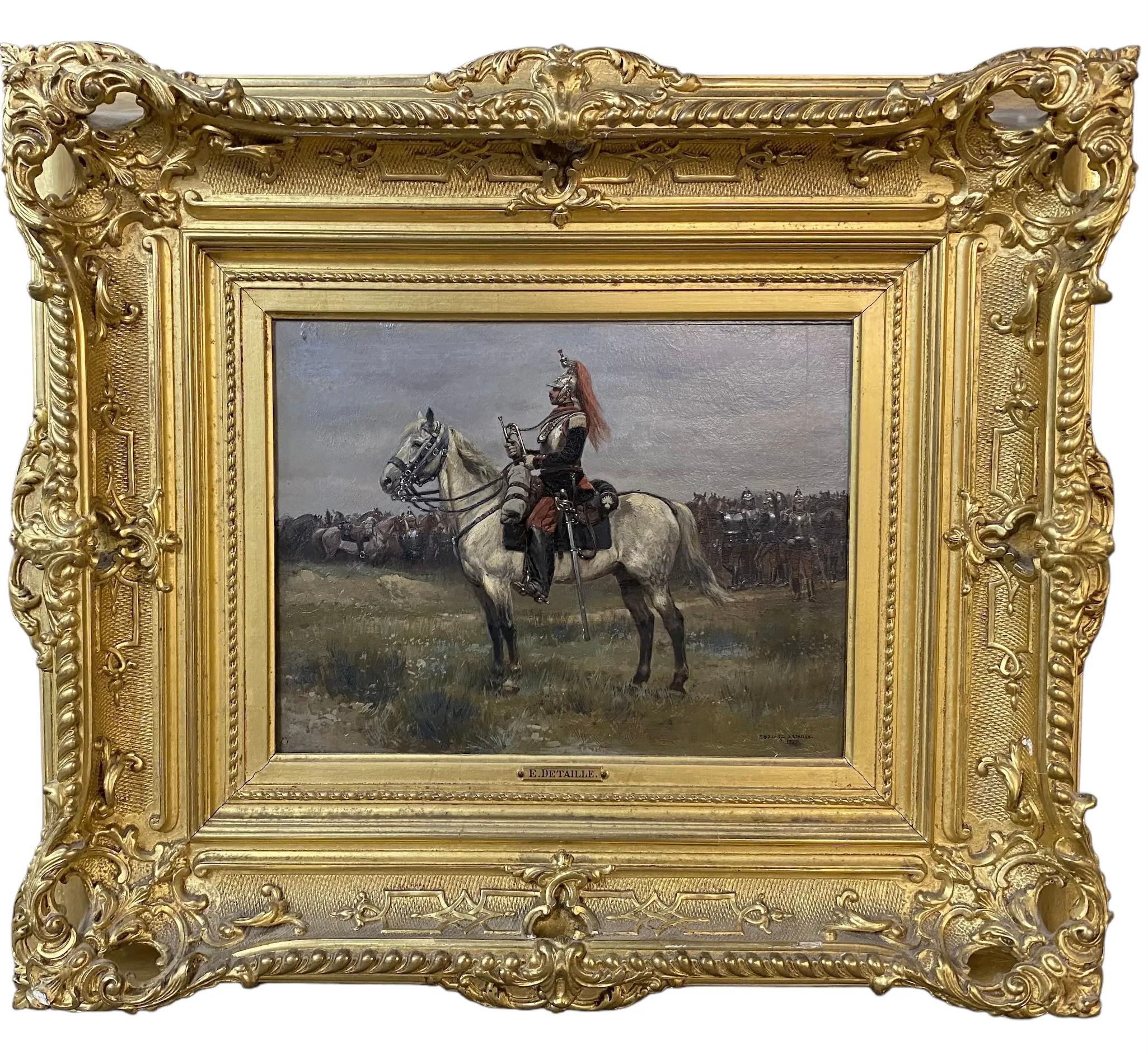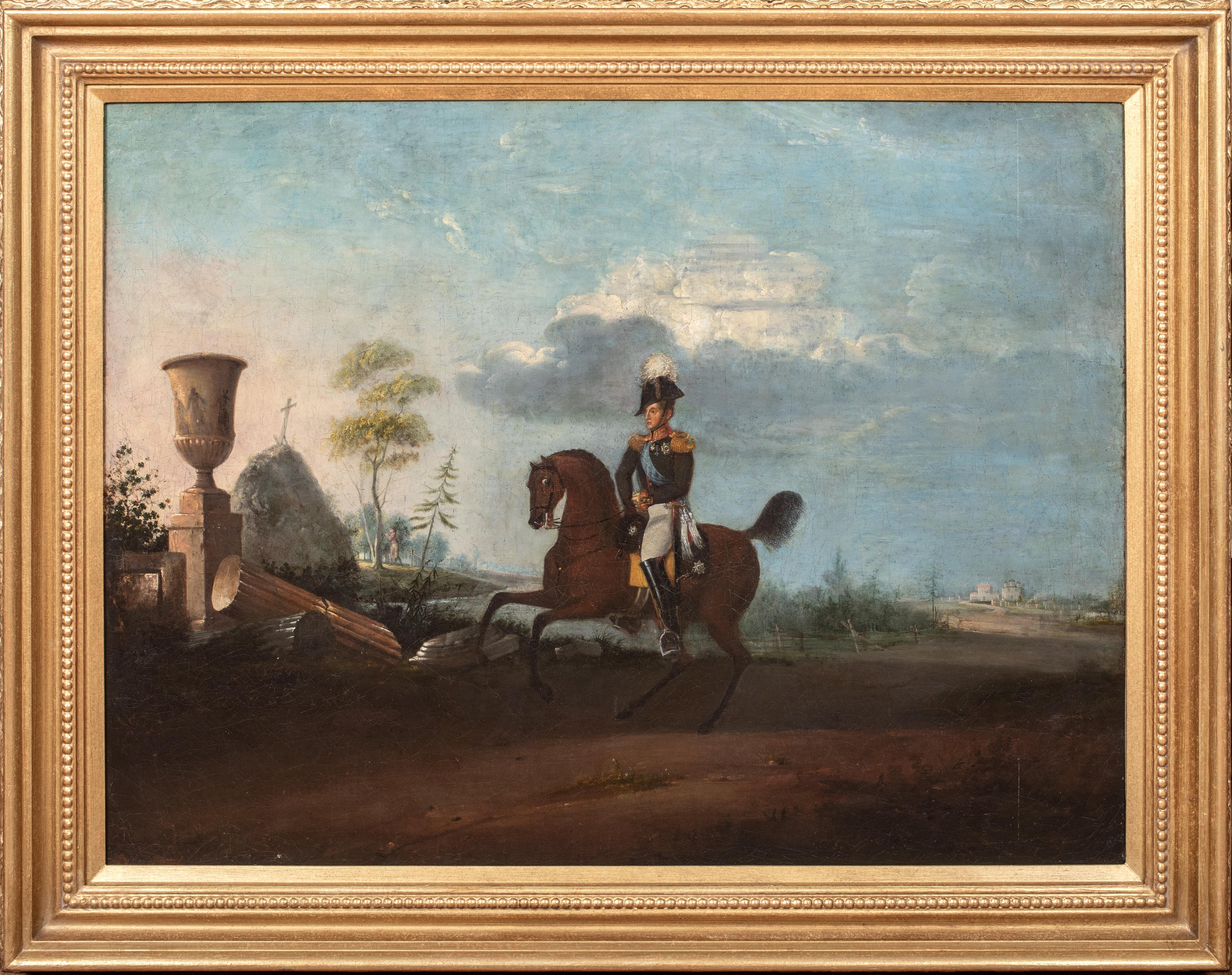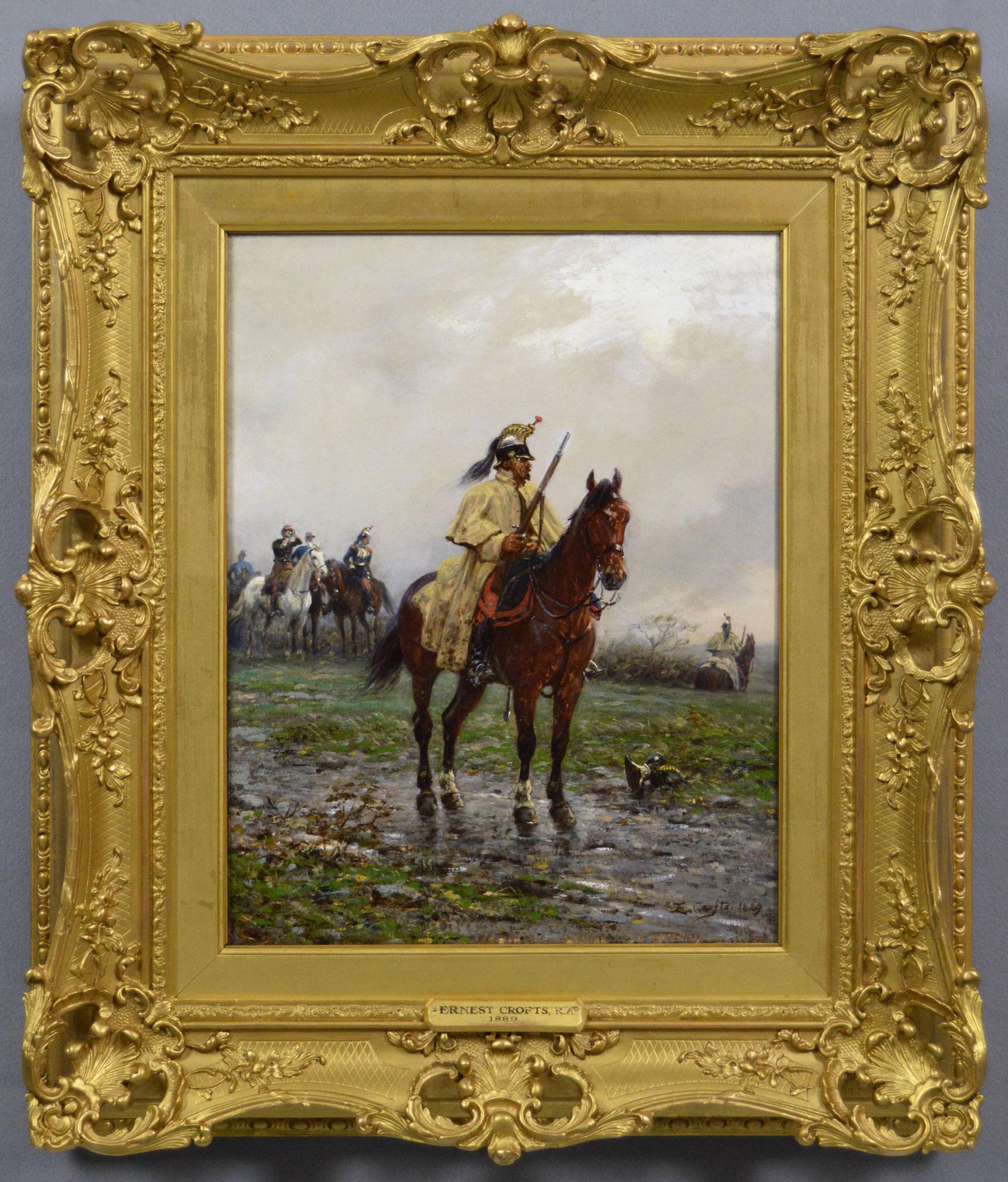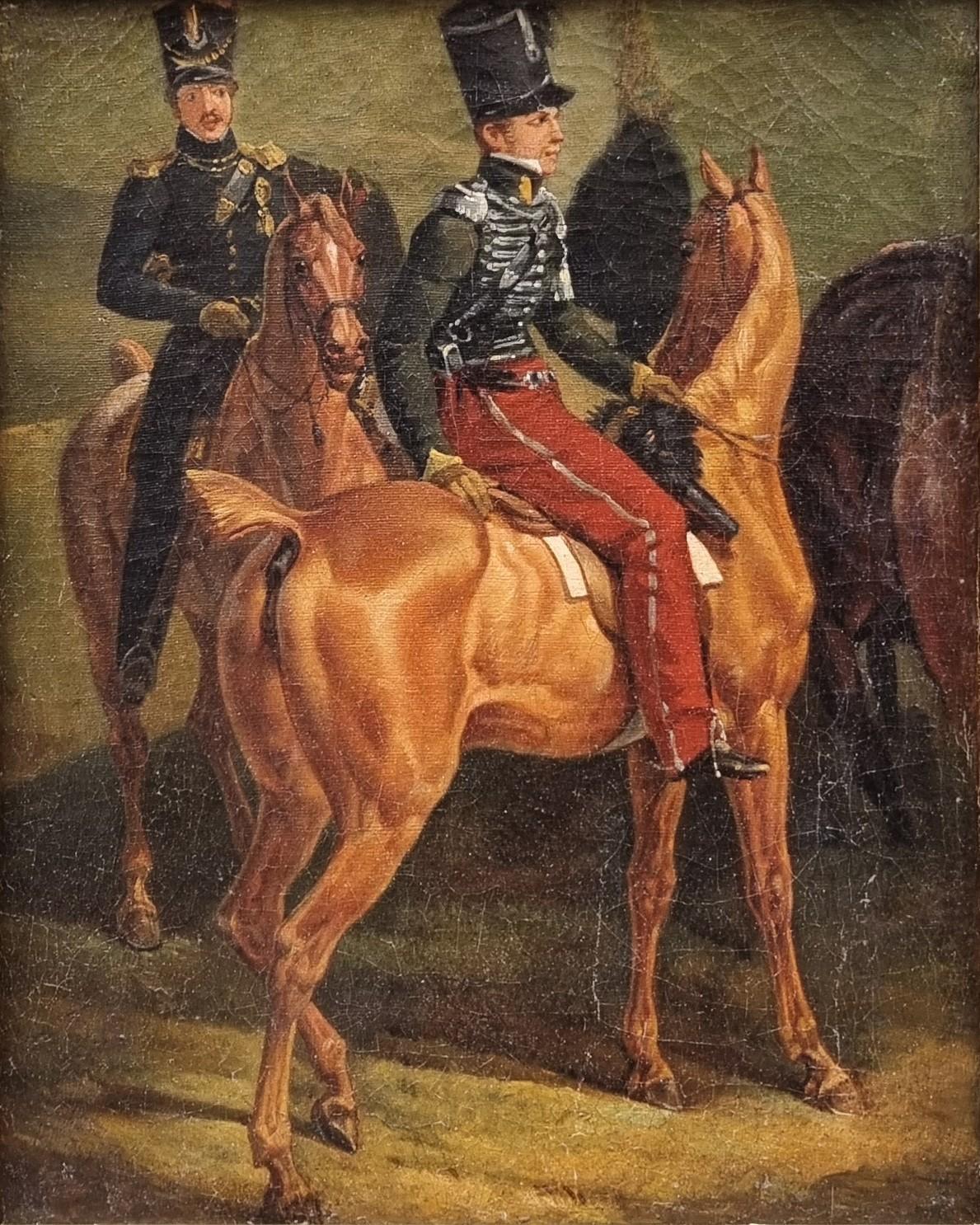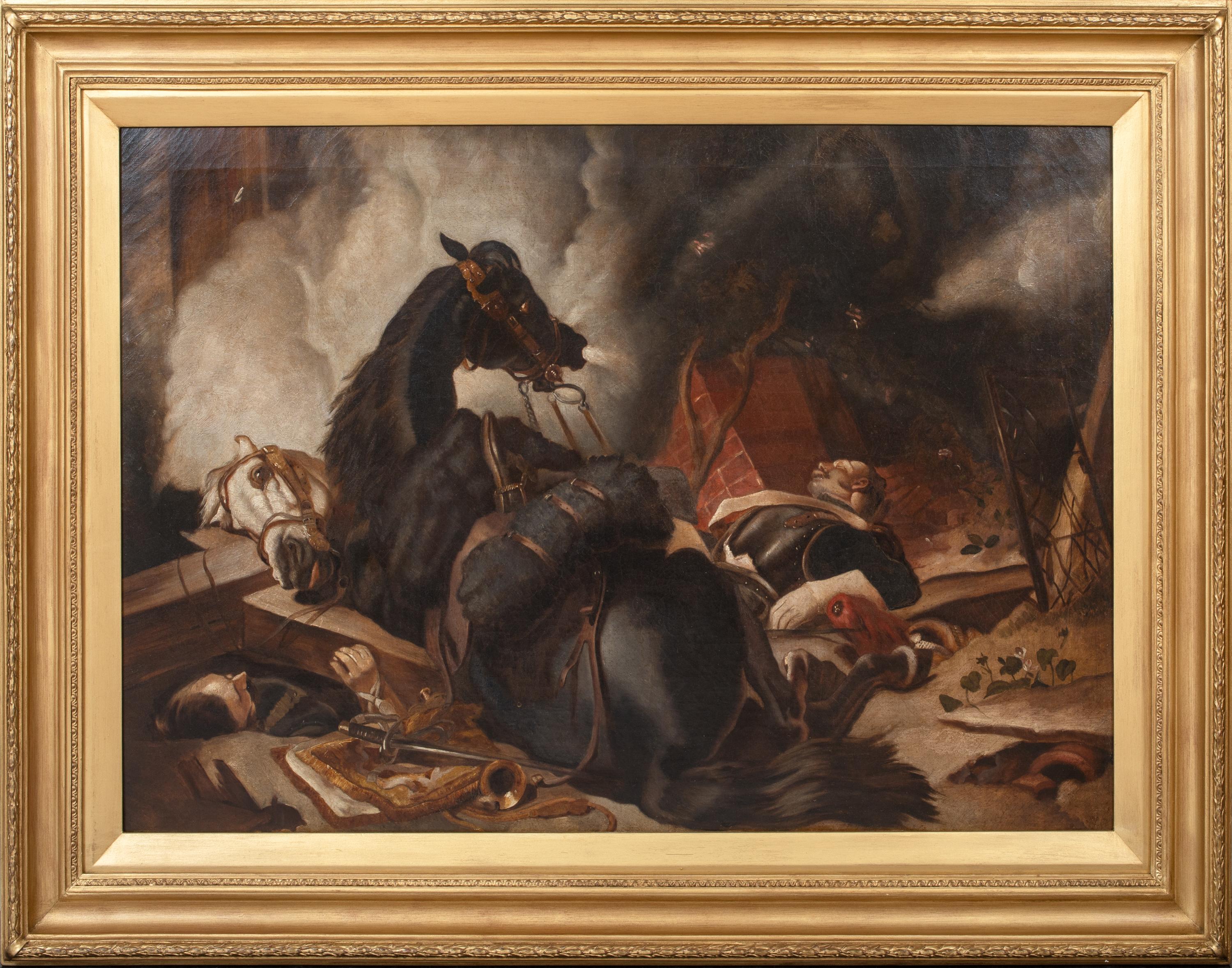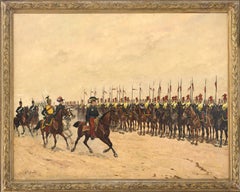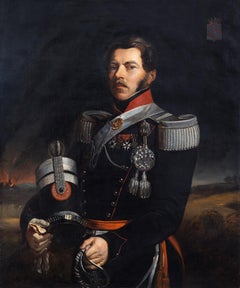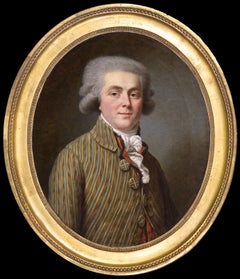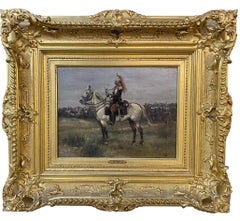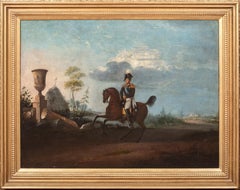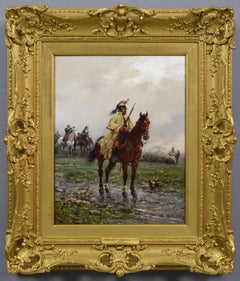Items Similar to Portrait of Russian cuirassiers colonel
Want more images or videos?
Request additional images or videos from the seller
1 of 9
Hippolyte LecomtePortrait of Russian cuirassiers colonel1817
1817
$11,358.61
£8,399.48
€9,500
CA$15,718.62
A$17,501.72
CHF 9,107.55
MX$211,242.40
NOK 114,217.12
SEK 107,885.26
DKK 72,343.02
About the Item
Hippolyte LECOMTE
(Puiseaux, 1781 – Paris, 1857)
Colonel of Russian cuirassiers
Oil on canvas
H. 33 cm; W. 24 cm
Signed and dated at the bottom towards the center 1817
Exhibition: Salon du Louvre of 1817, under number 504 of the booklet
Provenance: Philippe Quéval collection
Often reduced to a painter of battles and military subjects, Hippolyte Lecomte, described as an “excellent master” by Paul Marmottan, nevertheless worked in many registers. Troubadour style, genre scenes in the spirit of Boilly, drawings of costumes for the Opera and the Italian Theater between 1823 and 1830, and landscape. It was Pierre-Antoine Mongin who introduced him to this last genre, after initial training with Regnault. Born in Loiret, Lecomte exhibited at the Salon almost continuously from 1804 to 1847, obtaining a first class medal in 1808, and regularly good reviews. Thus, in Le Journal de Paris of July 23, 1817, he was distinguished as a landscaper, alongside Langlacé, Bouhot and Regnier: "...among the landscapers who were less well known... his color is perhaps a little raw; his foliage lacks lightness; but his style is frank and precise; and he renders well the general effect of a site". At the Salon of 1824: "Always wit and a piquant precision"; the nevertheless not very indulgent Auguste Jal wrote: "M. Hippolyte Lecomte deserves this year the praise of all the friends of the Arts". Lecomte was one of the first major lithographers in the 1810s. He notably produced several plates for the Voyage dans le Levant by the Count of Forbin, published in 1819, and, in 1820, all 380 colored lithographs for the Costumes civils et militaires de la Monarchie française de 1200 à 1820. He also had a brief collaboration with Baron Taylor for plates for the Voyages Pittoresques. Always close to the various powers, he built up a prestigious clientele, which included Joséphine, the Duchess of Berry and the Bourbons under the Restoration, Louis-Philippe, etc. His works are exhibited at Versailles (around thirty large canvases for the historical museum), Trianon, Saint-Cloud, Compiègne, Fontainebleau. In December 1807, Lecomte married Camille (1788-1858), the daughter of Carle Vernet, and thus became the brother-in-law of Horace Vernet, with whom he worked regularly. One of his sons, Emile Lecomte-Vernet, would become a famous orientalist painter. As for his best-known student, he was Jean-Jacques Grandville (1803-1847), who would succeed in caricature and illustration. Our small painting exhibited at the Salon of 1817, presented in its rich and important original frame, offers a fairly rare representation of the Russian heavy cavalry. The outfit corresponds to that of 1812-1814: high helmets in black pumpkin leather with visors at the front (with a brass border) and at the back, black steel breastplates. The officer at the head of his men, perfectly lit, stands out against a twilight sky with dark clouds, smoky from artillery fire and the movement of the troops. We find the dramatic atmosphere and energy of Géricault's paintings (the Wounded Cuirassier and the Officer of Horse Chasseurs Charging) presented at the Salons of 1812 and 1814, without obviously having the romantic power. The horse thus owes more to Carle Vernet (who also published in 1812 the collection La Grande Armée de 1812), the artist's father-in-law, with a brilliant but much less fiery execution.
- Creator:Hippolyte Lecomte (1781 - 1857, French)
- Creation Year:1817
- Dimensions:Height: 13 in (33 cm)Width: 9.45 in (24 cm)
- Medium:
- Movement & Style:
- Period:
- Condition:
- Gallery Location:BELEYMAS, FR
- Reference Number:1stDibs: LU1857215783172
About the Seller
3.0
Vetted Professional Seller
Every seller passes strict standards for authenticity and reliability
Established in 2017
1stDibs seller since 2022
5 sales on 1stDibs
- ShippingRetrieving quote...Shipping from: BELEYMAS, France
- Return Policy
Authenticity Guarantee
In the unlikely event there’s an issue with an item’s authenticity, contact us within 1 year for a full refund. DetailsMoney-Back Guarantee
If your item is not as described, is damaged in transit, or does not arrive, contact us within 7 days for a full refund. Details24-Hour Cancellation
You have a 24-hour grace period in which to reconsider your purchase, with no questions asked.Vetted Professional Sellers
Our world-class sellers must adhere to strict standards for service and quality, maintaining the integrity of our listings.Price-Match Guarantee
If you find that a seller listed the same item for a lower price elsewhere, we’ll match it.Trusted Global Delivery
Our best-in-class carrier network provides specialized shipping options worldwide, including custom delivery.More From This Seller
View AllCavalry review of the 2nd Lancers regiment
Located in BELEYMAS, FR
Georges HYON
(Paris 1840 – Saint Germain en Laye 1913)
Cavalry review of the 2nd Lancers regiment
Oil on canvas
H. 115 cm; W. 146.5 cm
Signed lower left
A student of Portalis, Georg...
Category
1870s French School Portrait Paintings
Materials
Canvas, Oil
Portrait of baron de Roisin - Gendarmerie general
Located in BELEYMAS, FR
Flemish school of the 19th century
Armorial portrait of Baron Henri de ROISIN (1787-1846)
in the uniform of a general of the gendarmerie (1835)
Oil on canvas
H. 108 cm; W. 90 cm
Bar...
Category
1830s French School Portrait Paintings
Materials
Canvas, Oil
Portrait of a man in armor
Located in BELEYMAS, FR
Attributed to Jacques DUMONT aka DUMONT LE ROMAIN
(Paris 1701 - 1781)
Presumed portrait of Louis-Joseph de Formanoir (?-1732)
Oil on canvas
H. 91.5 cm; L. 73 cm
Signed on the helmet:...
Category
1750s French School Portrait Paintings
Materials
Canvas, Oil
Portrait of a man during French Revolution
Located in BELEYMAS, FR
Antoine VESTIER, attributed to
(Avallon, 1740 - Paris, 1824)
Portrait of a man under the Revolution
Oil on canvas
H. 46 cm; L. 37 cm
Circa 1793-95
This beautiful unsigned portrait i...
Category
1790s French School Figurative Paintings
Materials
Canvas, Oil
Cardinal Mazarin portrait
Located in BELEYMAS, FR
French School circa 1645
Portrait of Cardinal Mazarin - Sketch
Oil on canvas
H. 41.5 cm; W. 27 cm
Provenance: Collection of the Reverend Georges Downing Bowles (1789-1863)
Would ...
Category
1640s French School Portrait Paintings
Materials
Canvas, Oil
Presumed portrait of Marie-Anne de Bourbon
By Nicolas de Largillière
Located in BELEYMAS, FR
Nicolas de LARGILLIERRE
(Paris 1656 – 1746)
Portrait of a woman, presumed to be Marie-Anne de Bourbon, Princess of Conti (1666-1739)
Oil on oval canvas
H. 8...
Category
Early 1700s French School Figurative Paintings
Materials
Canvas, Oil
You May Also Like
Portrait of Colonel Charles-Louis-Prosper Marquis de Chérisey (1786-1837)
Located in Paris, IDF
After Louis-Stanislas MARIN-LAVIGNE (Paris, 1797 – Paris, 1860)
Portrait of Colonel Charles-Louis-Prosper Marquis de Chérisey (1786-1837)
in the uniform of commander of the 38th lin...
Category
Mid-19th Century French School Portrait Paintings
Materials
Oil
Horse & French Military Rider
By Jean Baptiste Édouard Detaille
Located in Milford, NH
A finely detailed oil painting of a horse and French military rider with bugle by French artist Edouard Jean Baptiste Detaille (1848-1912). Detaille was born in Paris, France into a...
Category
1880s Figurative Paintings
Materials
Oil, Panel
Portrait Of Emperor Nicholas I Of Russia (1796-1855) On Horseback, 19th Century
Located in Blackwater, GB
Portrait Of Emperor Nicholas I Of Russia (1796-1855) On Horseback, 19th Century
circle of Heinrich Muller (1781-1851)
Large 19th Century portrait of Nicholas I, Emperor of Russia o...
Category
19th Century Portrait Paintings
Materials
Canvas, Oil
19th Century historical military oil painting of a French Cuirassier on a horse
By Ernest Crofts
Located in Nr Broadway, Worcestershire
Ernest Crofts
British, (1847-1911)
The Search Party
Oil on canvas, signed & dated 1889
Image size: 17.5 inches x 13.5 inches
Size including frame: 27 inches x 23 inches
An excellen...
Category
19th Century Figurative Paintings
Materials
Canvas, Oil
French Romantic Painting 19th Circle of Horace VERNET The Hussars Horses
By Émile Jean-Horace Vernet
Located in PARIS, FR
French school of the 19th century (Entourage of Horace VERNET)
The hussars
Oil on canvas
Unsigned
41 x 33.5 cm (58 x 50 cm with the frame)
Beautiful frame Regence style
Good conditio...
Category
Mid-19th Century Romantic Figurative Paintings
Materials
Oil
Napoleonic Wars Cuirassier Horse, 19th Century
By Sir Edwin Landseer
Located in Blackwater, GB
War Horse, 19th Century
after Sir Edwin Henry Landseer (1802-1872)
Large 19th century Napoleonic Cuirassier War Horse scene, oil on canvas. Excellent quality and condition depicti...
Category
19th Century Animal Paintings
Materials
Canvas, Oil
More Ways To Browse
Russian Large Paintings
Russian School Oil
Antique Animal Plate
Bourbon Sign
Small Brass Animals
Russian Frame Antique
Antique Russian Paintings
Russian Leather
Antique Brass Painting
Antique Russian Plates
Russian Painted Plates
Russian Horse
Horse Battle
Oil Painting On Leather
Oil Portrait Officer
Jacques Philippe
Paul Taylor
Large Battle Scene Painting
